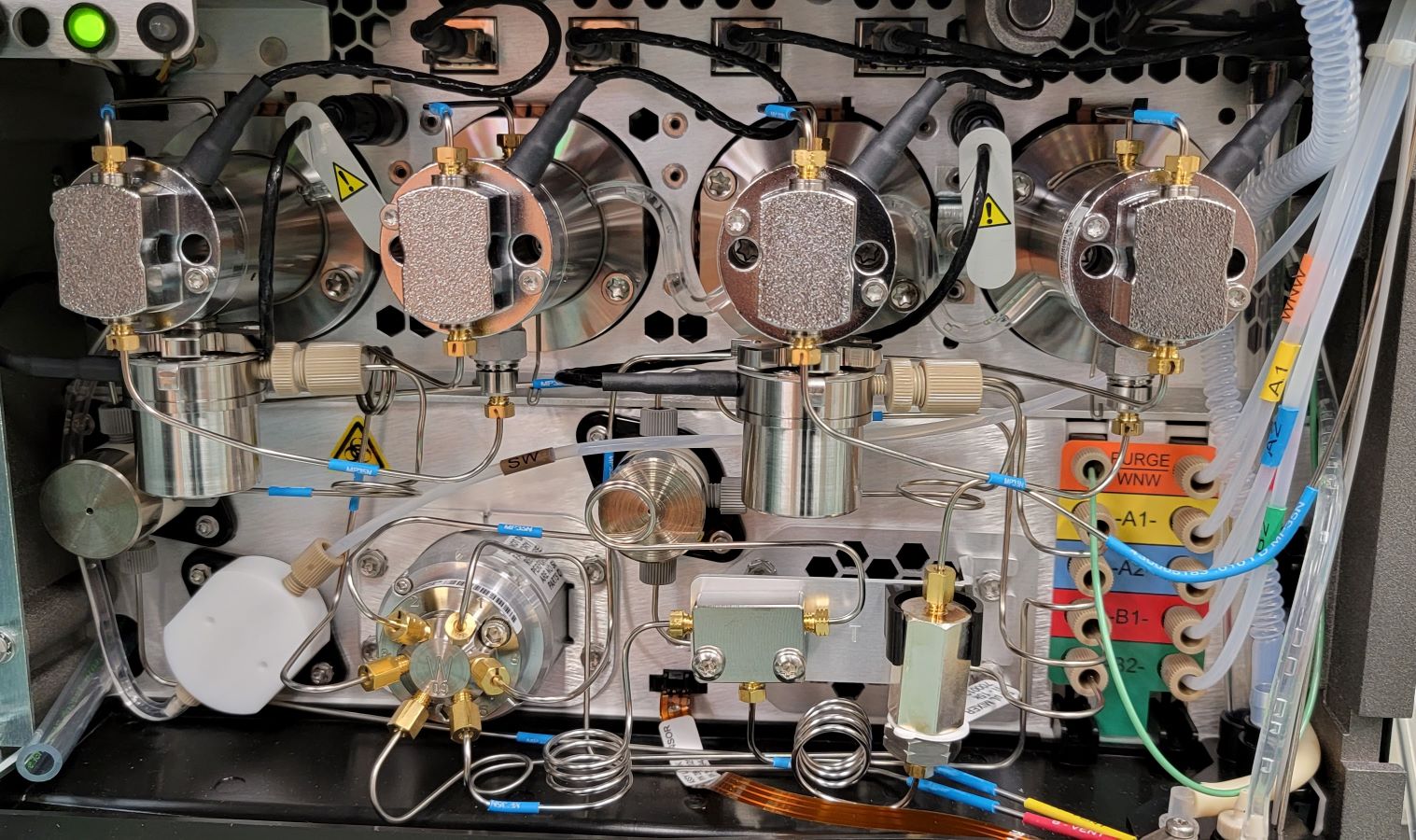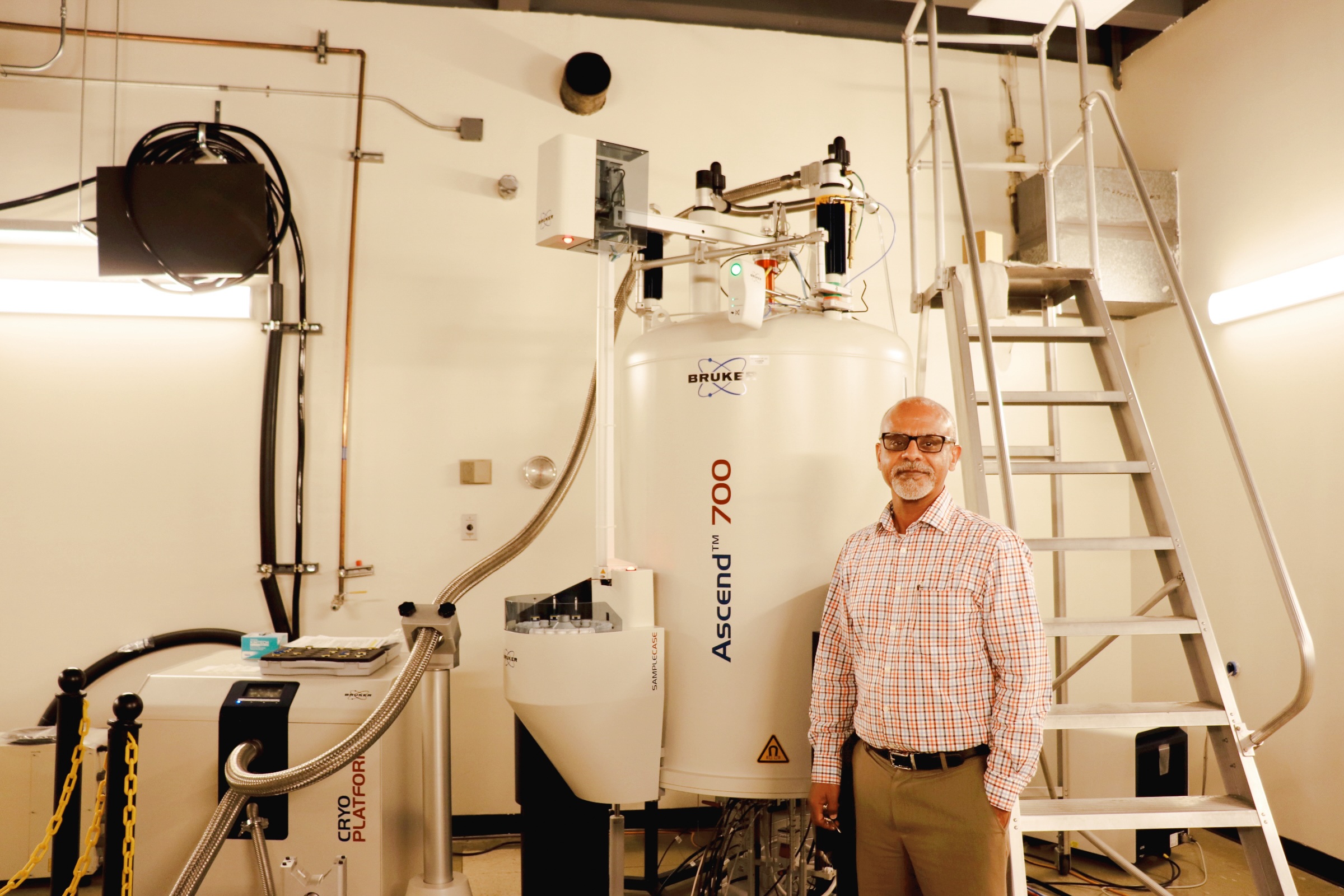New Grant Supercharges LSU’s Analytical Science Infrastructure: Major Upgrades for MSF and NMR Facilities
July 03, 2025

New funding will streamline workflows by centralizing sample preparation in the Mass Spectrometry Facility (MSF) and adding variable-temperature capabilities to the Nuclear Magnetic Resonance (NMR) Facility—advancing research, collaboration, and student training. Pictured: a Synapt pump at the MSF.
– Photo Credit: Fabrizio Donnarumma
The LSU Mass Spectrometry Facility (MSF) and Nuclear Magnetic Resonance (NMR) Facility have long been cornerstones of research support at Louisiana State University and beyond. With a mission centered on providing advanced analytical services in mass spectrometry and NMR spectroscopy, these facilities offer more than just instrumentation; they provide a collaborative environment where researchers across disciplines receive support in experimental design, sample preparation, and data analysis. Now, thanks to a new enhancement grant from the Louisiana Board of Regents, both the MSF and NMR Facility are expanding their capabilities in ways that will significantly streamline workflows and raise the quality of research output.
The recently awarded grant, titled "Enabling new sample preparation techniques in mass spectrometry and variable-temperature capabilities for nuclear magnetic resonance (NMR) spectroscopy," totals $69,199, with an LSU cost share of $45,287. “This grant was designed to help us consolidate sample preparation and analysis into one space,” said Dr. Fabrizio Donnarumma, Director of the MSF. “Until now, users often had to prepare their samples in different buildings or borrow equipment from other labs before bringing them here. With this new benchtop instrumentation, we’ll be able to carry out almost all the necessary steps within the facility itself.”
The grant was awarded through the highly competitive Board of Regents Departmental Enhancement Program and reflects a collaborative effort among Dr. John Pojman, Professor and Chair of the Department of Chemistry; Dr. Fabrizio Donnarumma, Director of the MSF; and Dr. Thomas Weldeghiorghis, Director of the NMR Facility. While each contributed expertise to a distinct portion of the proposal, their shared goal was to elevate LSU’s capacity in analytical chemistry by strategically aligning these two core facilities.
Dr. Weldeghiorghis emphasized the complementary nature of their work. “Mass spectrometry and NMR provide different but equally critical insights,” he said. “Mass spectrometry is highly sensitive and often destructive, while NMR is non-destructive but less sensitive. Together, they allow us to see both the forest and the trees. With this grant, we’re not just enhancing equipment—we’re building a more complete picture of chemical systems.” His portion of the grant focused on acquiring cooling units that will enable the NMR facility to perform variable-temperature experiments. “We’ve had the probes, but not the cooling units,” he added. “Now we’ll be able to conduct experiments at much lower temperatures and observe transient species and reaction intermediates in much greater detail.”

Dr. Thomas Weldeghiorghis with the Bruker AVANCE Neo 700 MHz NMR Spectrometer. The system is equipped with a cryoprobe for solution-state NMR and both 3.2 mm and 0.7 mm Magic Angle Spinning (MAS) probes for solid-state NMR experiments.
– Photo Credit: Anna Slaton
The NMR Facility in LSU’s Department of Chemistry houses six spectrometers with ¹H resonance frequencies ranging from 400 to 700 MHz. These include a 700 MHz dual solution/solid-state Bruker Avance Neo with a helium-cooled triple-resonance Cryo-probe and MAS probes spinning up to 111 kHz, a 500 MHz system with both Cryo and broadband probes, and four 400 MHz spectrometers for solution-state, solid-state, and diffusion studies. All instruments are connected to Linux workstations for seamless data transfer and offline/remote analysis. The facility supports researchers across LSU as well as external academic and industry partners throughout Louisiana and beyond.
Housed within the Department of Chemistry, the MSF serves as both a core and user facility, supporting a wide range of academic and industrial partners across the state and nation. It currently houses six mass spectrometers with applications spanning organic, inorganic, and biological chemistry. But Donnarumma emphasizes that instrumentation alone doesn’t define a facility’s success. “We are not just a place that runs samples,” he said. “We help users design experiments, we train them, and we troubleshoot problems. A facility without staff support is just a room full of machines. The people are what make it valuable.”
The MSF’s instrumentation has grown steadily, most notably in 2023 when it received both an NIH S10 grant and an NSF MRI grant. These awards brought in the Waters Synapt XS platform for high-resolution metabolomics and lipidomics and the Bruker rapifleX—the fastest MALDI-TOF/TOF instrument on the market—for mass spectrometry imaging. “These two systems alone have radically expanded what we can offer,” said Donnarumma. “We’re talking about molecular-level imaging, post-translational modification mapping, and high-throughput small molecule screening.”
The MSF is also committed to staying at the forefront of emerging analytical techniques. “We stay current through two main channels,” Donnarumma explained. “We’re always applying for new instrumentation grants, but we also stay close to our users, the scientific literature, and specialized journals. If we come across a new method that looks promising, we rigorously test it in-house. Only after it proves its value do we incorporate it into our standard protocols.”
Both facilities extend their influence beyond LSU. The MSF frequently partners with other campuses and industries that need advanced analytics or help with experimental troubleshooting. “Sometimes they just need a second opinion, and we’re here for that,” said Donnarumma.
Science doesn’t happen in isolation. It happens when tools, people, and ideas come together. That’s what this grant supports—and that’s what makes this facility special.
Fabrizio Donnarumma, director of the Mass Spectrometry Facility at LSU
The new instruments supported by this grant will also enhance student training—something both facilities are deeply invested in. Gabreyela Gonzalez, an undergraduate majoring in chemical engineering and minoring in chemistry, has worked with the MSF team for over a year. She’s been involved in everything from prostate cancer sample prep to lab inventory and chemical waste compliance. “This lab has changed how I see my future,” Gonzalez said. “It’s shown me how science works outside the classroom, and it’s made me consider graduate school, maybe even working for NASA one day.”
Gonzalez said her time at the MSF taught her how mass spectrometry connects to much bigger questions. “Whether it's forensic analysis, cancer research, or propulsion chemistry, this technology is shaping how we understand and solve problems in the real world,” she said. “It’s not just about data. It’s about using science to serve people.” Another graduate student, Ben Wiser from Dr. Anthony Engler’s lab in the Department of Chemical Engineering, said, “Variable Temperature NMR is extremely advantageous for analyzing in situ polymerizations! I’m thrilled about this addition and believe it will be instrumental in our ability to understand and design new chemically recyclable plastics—some of which may even be useful for state-of-the-art semiconductor fabrication.”
For Dr. Donnarumma, that sentiment captures what the MSF stands for. “Science doesn’t happen in isolation,” he said. “It happens when tools, people, and ideas come together. That’s what this grant supports—and that’s what makes this facility special.”